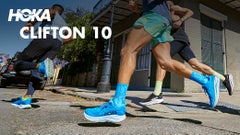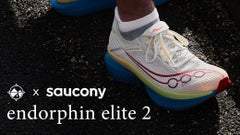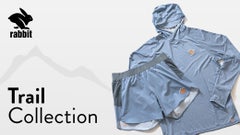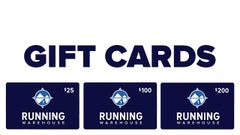A Beginner's Guide to Track & Field Throwing Events
Shotput, Discus, Hammer, and Javelin Explained
Updated: November 4, 2024 by Marie Hobbs
It's that time of year again when track and field is ramping up, so we want to prepare you for the right gear to set personal records this season! We asked Harry Marra, who has been in the track and field world as an athlete and coach for 60 years to give insight on selecting the right shoe for the various throwing events for track and field, which are the Shot Put, Discus, Hammer Throw, and Javelin.
Harry Marra is best known as the coach of decathlon world record holder Ashton Eaton and Olympic medalist Brianne Theisen-Eaton. Marra's other accolades include 2016 IAAF World Athletics Coach of the Year, 2012 Nike Coach of the Year, and the author of the 2022 book Stories From the Passenger Seat: Lessons Learned From a Lifetime of Coaching.
If you are a beginner to the sport of Track & Field and want a foundational shoe as you explore the throwing events, check out our Best Track & Field Spikes and Shoes for Beginners guide to get you started. Now, let's dive into the various events for all our throwers out there.
What Are the Different Track & Field Throwing Events
Track and Field throw events test an athlete's strength, coordination, and throwing ability with different implements of various weights and shapes. These different events have a long, rich history going back to ancient Greece's original Olympic pentathlon events and have become popular competitions that we see in athletics today. There are four different events that lie within the Throw category in Track and Field: Shot Put, Discus, Hammer, and Javelin.
Shot Put

The Shot Put competition layout consists of a throwing circle, a stop board, and a landing sector or grass area. The competitor stands inside a circle and attempts to "put" a weighted ball as far as they possibly can into the landing area without going out of the throwing circle during the throw. The weighted ball, or shot, itself will vary in weight, depending on the level of competition and the gender of the participants. The term "put" is used instead of throw, as the arm motion is more of a push motion from the body versus a technical throw motion.
What to Look For In a Shot Put Shoe
The shot put throw will require a shoe that has maneuverability and some grip dependent on your throwing style. The two throwing styles are the traditional glide and the increasingly popular rotational technique (also used for the discus and hammer throw). Based on your event and technique, there are two shoes to choose from with a slight variance in their outsoles: Textured Outsole/Glide Movement Throw Shoe and Smooth Outsole/Rotational Throw Shoe. The Textured Glide Movement throw shoes are grippier as the movement is a simple movement of transferring your weight from one leg to the other as you throw. These shoes are best suited for wet rings or beginners of the rotational technique that can benefit from slower rotational speed as proper technique is learned. The slick nature of the Smooth Outsole throw shoe is better suited to dry rings or for advanced athletes who can effectively throw at a faster pace when using the rotational technique.
Discus Throw

The Discus throw is an event from the ancient Greek pentathlon dated to around 708 BC, so it has a rich history in the sport of track and field. In this event, the athlete throws a heavy disc, called the discus, into a throwing landing area for distance. The discus will vary in weight depending on the level and gender of the competitor and can be made from wood, plastic, fiberglass, rubber, carbon fiber, or metal, depending on the thrower's preference and competition.
The Discus throw features a throwing circle, a protective cage along the back and sides of the throwing area, and a landing sector located in the grass area inside the track. The rotational throw technique generates speed and, in return, energy before the disc is launched into the landing sector for measurement. Because of this technique, the athlete needs to have not only strength and speed but also balance and accuracy in the release.
What to Look For In a Discus Shoe
Rotational throw shoes are appropriate for the Discus throw event. Rotational shoes often have smooth outsoles that allow for faster rotations and a mid-foot strap that provides a solid lockdown throughout every phase of the throw. The grippier nature of the Textured Outsole Throw shoe is better suited for use in wet rings or for beginners who benefit from slightly slower throwing speeds as they learn proper mechanics.
Hammer Throw

The Hammer throw is an event where the participant throws a weighted ball on a steel wire with two hands for distance. The hammer throw derives its name from an ancient throwing sport in which an actual hammer, fitted with an additional weight, was the object tossed.
Much like the event space for the Discus throw, the Hammer throw includes a throwing circle, a protective cage along the back and sides of the circle, and a landing sector (typically a grassy area), although the circle for the hammer throw is slightly smaller. For the hammer throw technique, the competitor makes three full, quick turns of their body before flinging the weight into the grassy landing area. This event requires strength, balance, and proper timing to execute the throw safely and effectively.
What to Look For In a Hammer Throw Shoe
The main features of what to look for in a Hammer throw shoe are consistent with what you would look for in the Discus shoe or any of the rotational throw shoes. Most importantly, you want to look for a comfortable, snug fit, stability/security for that good lockdown feel on your foot, and also durability and versatility if you are planning to use the same shoe for training and competition, especially if you are using them for multiple events.
The shot put, discus, and hammer throw will require a shoe that has maneuverability and some grip dependent on your throwing style.
 Textured Outsole
Textured Outsole Smooth Outsole
Smooth OutsoleJavelin

Inspired by the act of hunting animals and warfare, the Greeks incorporated the Javelin throw into the Ancient Olympics to what we know of it today. The Javelin is a throwing event in which athletes throw a metal-tipped javelin as far as possible, using a combination of strength, power, timing, coordination, and precision. This event consists of a runway, a throwing arc, and a landing sector, which is usually a grassy area. The athlete will run up the runway to generate momentum and transition the energy from the run-up as they plant their front foot to deliver the javelin with an explosive, quick release.
What to Look For in a Javelin Spike
Javelin throw shoes, often called Javelin boots, are uniquely designed for the Javelin throw alone and are often seen in a high-top version for maximum stability and power transfer support. These shoes are the only throw shoes that have spikes on the outsole. Many coaches, like Coach Marra, like this higher option, especially for beginners, to help save and protect the athlete's ankle. Javelin shoes have spikes in the front of the shoe and the heels and are very sturdy with a firm outsole to provide maximum traction when planting to throw. A stable front area of the shoe with a protective cap and secure lacing is also in the design to make sure the athlete has full support of movement and decreased injuries.


Important Aspects for a Throw Shoe

Fit
One of the most important considerations in selecting your shoes for the throwing events is the comfort of fit. Just as a tennis player wants their racquet to be an extension of themselves, your throwing shoes should feel like a secure and natural part of your foot that gives you extra support to execute your throw. Your throw shoes should fit snugly but not overly tight, which will cause more harm than good. You want your shoe to have a snug but comfortable lockdown, which is necessary to improve performance and avoid injury, as it will keep your footing secure during the throwing technique you are executing. Most throw shoes come with VELCRO straps at the midfoot for that optimal comfortable hold on your foot. Check out our How to Fit Track Spikes guide, where we go into a little more depth on the fit of the different types of shoes used for Track and Field.
Durability
Throwing shoes, by nature, are much heavier than most track and field shoes, as they serve the purpose of ensuring that the thrower maintains better stability on the ground, especially during the throwing phase. In Coach Marra's video, he expresses the importance of having a comfortable and durable shoe that has firmness, a good heel counter, and good traction for your event. For hammer and discus throwers and shot putters, many athletes can use the same shoe for all events, which saves money in the long run, and there's no need to change your footwear between events. With that said, you want to make sure that the outsole and midsole are vigorous and can keep you comfortable and safe. Having a couple of pairs of throwing shoes to alternate between training and competing is also a consideration for those multiple-throwing athletes.
Versatility
Versatility goes hand in hand with the durability aspect of a throwing shoe, as we just touched on. Selecting a throwing shoe for multiple events depends on factors such as the events you will be doing, the price you want to spend, and the durability of the footwear for enduring practice and competition. The Javelin is the one throwing event that requires a specific shoe; however, if you throw the Shot Put and Discus and use the rotational throwing technique, you could choose a Rotational Throwing Shoe to participate in both events.
Stability
Just as versatility and durability complement each other in their attributes for a throwing shoe, stability complements the fit of your shoe. When it comes to throwing, the athlete arrives at a position of power to deliver force, and proper technique and shoes play an essential role in providing the stability needed for a controlled, powerful release. Throw shoes with good traction allow momentum to build and reduce the possibility of slipping during the throw. Meanwhile, a firm lockdown keeps the foot secure and stable on the ground, especially during the throwing phase.






















